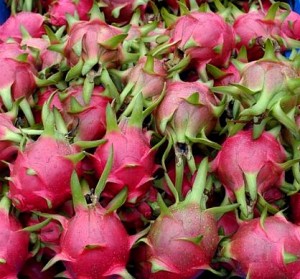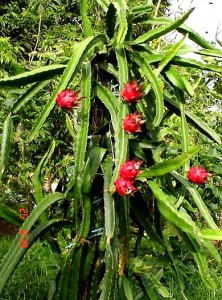 The Pitaya or commonly known as Dragon fruits belongs to the Family Cactaceae under the genus Hylocereus and Selenicereus. It is a native plant from Mexico, Central and South America. It is an extremely beautiful fruit that has dazzling flowers and an intense shape and color. The dragon fruit is usually a dark red color, although some types of this fruit are pink or yellow. The skin of the dragon fruit is a thin rind. The skin is usually covered in scales, and the center of the fruit is made up of a red or white, sweet tasting pulp. It can be taken as fruit, flower, vegetable, health product and medicine as well, called “priceless treasure”.
The Pitaya or commonly known as Dragon fruits belongs to the Family Cactaceae under the genus Hylocereus and Selenicereus. It is a native plant from Mexico, Central and South America. It is an extremely beautiful fruit that has dazzling flowers and an intense shape and color. The dragon fruit is usually a dark red color, although some types of this fruit are pink or yellow. The skin of the dragon fruit is a thin rind. The skin is usually covered in scales, and the center of the fruit is made up of a red or white, sweet tasting pulp. It can be taken as fruit, flower, vegetable, health product and medicine as well, called “priceless treasure”.
They are one of the most widely distributed members of the family, and are now found on six continents. This vine-like epiphytic cactus is also cultivated in Southeast Asian countries such as Malaysia, Vietnam, Taiwan, Thailand, and the Southeast Coast of China.
Introduced in the Philippines in the 1900’s through trading and exchange of goods by the Spaniards and the Filipinos. Because of its production and economic importance, this fruit showed competitive advantage for the local fruit industry.
Recently, dragon fruit has become a popular commodity in the Philippines particularly among farmers in Cavite because of its commercial value.
How to grow Dragon Fruit or Pitaya:
Health Benefits
- Prevent formation of cancer using free radicals (Pyhtoalbumins as anti-oxidant)
- Enhance the body metabolism (Protein)
- Improves digestion (fiber)
- Reduce fat (fiber)
- Improve memory (Carotene)
- Strengthens bones and teeth development (Calcium)
- Tissue development (Phosphorous)
- Help to metabolize carbohydrates and produce energy (Vitamin Bl)
- Improves appetite (Vitamin B2)
- Moisturize and smoothen skin and decrease bad cholesterol level (Vitamin B3)
- Improves the immune system and promotes healing of cuts and braises (Vitamin C)
- Reduces hypertension (B-Sitosterol)
- Use for liver, digestive and endocrine problems (antimutagenic activity & hepatoprotective effects)
- Helps in reducing blood glucose level in people with non-insulin dependent hyperglycemic conditions
Dragon fruit is richer in fiber, vitamins, minerals and phytoalbumins.
Uses:
- Preserves/spreads
- Fruit pizza
- Salad
- Sherbets & Sorbets
- Beverages
Varieties
1. Red Varieties – Fruits have been used to combat anemia
a) Hylocereus undatus:
- Climbing cactus with large, scented, night blooming flowers
- Fruit weighs 1 kg or more with light melon-like taste
- Fruit has bright red skin, with translucent white flesh and tiny black seeds
- With triangular cross-section of its stem and minimal spines
b) Hylocereus polyrhizus
- Fruit weighs up to 1 kg
- With red skin, dark-red flesh which contains small black seeds
- Stems have more spines
2. Yellow Variety
- Selenicereus megalanthus
- Smaller fruit with yellow skin and clear to white flesh containing edible black seeds
- Sweeter than red varieties
- Contains the heart tonic captine
Elevation
Optimum elevation is 100 to 800 meters above sea level preferably with 30% shade to full sun as Pitaya grows slowly when shaded.
Propagation
Pitaya is propagated by seeds or stem cuttings. The latter is more preferred. Stem cuttings were raised in the nursery for 2 -3 months.
Plant Establishment
Recommended planting distance is 3 meters between concrete posts and 4 meters between rows. A narrower spacing gives quicker production than larger spacing. Higher density plantings produce quicker returns, but plants will begin to crowd each other sooner.
Planting is done at 3 to 4 plants per post, Rooted cuttings may be planted directly or kept in 9? x 13? black polyethylene bags. For direct rooted cuttings, position them 15 cm away from the post at and angle leaning towards the post. Direct planting is 5 cm depth, while for transplants, hole depth should be same as height of plastic bag’s soil depth. Irrigate and protect newly emerging foliar buds from ants and other insects.
Fertilizer/Nutrients
Apply a handful of complete fertilizer (14-14-14) 3 months after planting and continue fertilizer applications every 3 months thereafter. Pitaya also requires organic matter. Nitrogen is necessary during the vegetative growth of the plant and is reduced during dormant and pre-flowering stages (later December to mid-March).
Apply foliar sprays every 2 weeks during vegetative stage and less during fruiting stage.
Frequency of fertilizer application varies according to personal judgment and preferences. Optimum frequency and quantity depends on the plant’s response. Pitaya is very responsive to soil and foliar fertilizer applications.
Pruning
Major and minor pruning is a regular orchard operation regardless of age of Pitaya. Prune to obtain an open, manageable and productive umbrella shaped canopy.
Pest and Diseases
The roots, stems, foliar and flower buds, flower and fruit are attacked by a range of pests and diseases. Pests include mites, thrips, ants, scale insects, mealy bugs, beetles, slugs, borers, nematodes, fruit flies and rodents such as mice, birds, or bats.
- Chlorpyrifos-based insecticides may be used to control ants and other pests as well.
- Copper-based fungicides (copper, copper oxychloride, dithane M45, cupravit, mancozeb, etc. can be applied at appropriate dosage and spray as needed. Systemic fungicides such as benomyl, carbendazim, azcxystrobin,etc. are also effective in wide range of pitaya diseases.
Avoid, however, pesticide spraying when nearing harvest time. Bagging of green fruit using clear perforated polyethylene bags (China-made) are recommended to protect fruit from fruit fly stings.

Weeding/Sanitation
Gasoline-driven weed cutters are recommended for orchards. Hand weed within the inner 30 diameter of each post to avoid damage to plants. Control weeds as they harbor pests and compete with soil nutrients.
Irrigation
Water requirement of Pitaya is similar to papaya. Irrigation is critical during fertilizer applications and fruiting. Excess drying of soil and less frequent irrigation results in abnormally high splitting of fruit. For newly planted Pitaya, allow soil to dry before irrigation to avoid rots.
Harvest
Harvesting indices include full red coloration of the terminal petal and swelling of the navel end to the point of cracking. Based on Davao planting, harvest period include: First Cycle of harvest -June – October; 2nd Cycle of harvest – December – January.
- Fruit is harvested from 30-50 days after flowering
- 5-6 fruit crop cycles a year (between May and November)
- Stored at 5°C with 90% relative humidity and can be stored for up to 40 days
- Average weight per fruit ranges from 200 to 1.2 kg
For more information, please contact:
Teddy F, Tepora, Ph. D,
Program Leader, Dragon Fruit R&D, Research Center
Don Severino de las Alas Campus Cavite State University, Indang, Cavite
Phone: (046) 415-1355
Lorna C. Matel, MBA, Manager
Farmers’ Information & Technology Services (FITS) Center Research Center
Don Severino de las Alas Campus Cavite State University Indang, Cavite
Phone: (046) 862-0859
Mr. Noel T. Estellena
Senior Agriculturist
DA-SMIARC, Bago Oshiro, Tugbok District, Davao City
Telefax; (082) 293-0109 or (082) 293-0136
E-mail: [email protected]
Source: trc.dost.gov.ph, dragonfruitpitaya.com; Photos: tootoo.com, organic-fertilizer.org